The DisComPoSE researchers participated in a session of the conference The Italian culture of the eighteenth century and its transnational connections, organized on 20th-22nd June 2023 in Naples, as part of the activities of the international project Rethinking Eighteenth-Century Italian Culture and Its Transnational Connections realized by the California State University, Long Beach, in collaboration with the University of Naples Federico II.
The project, led by Clorinda Donato (CSULB) and Pasquale Palmieri (UniNa), aims to study the documents that testify to the importance of Italy in the transnational cultural landscape of the eighteenth century. One of its main objectives is the selection of a list of Italian texts of the eighteenth century that have never been translated into English or need to be retranslated and accompanied by a scientific apparatus.
For this purpose, the thousands of texts and images collected, recorded and analysed within the DisComPoSe project will be invaluable. During the session chaired by Anna Maria Rao which saw the participation of four members of the team led by Domenico Cecere, there was a discussion about how the reasons for and ways of communicating the news about natural disasters changed between the late seventeenth and the second half of the eighteenth century.
One of the basic assumptions of the DisComPoSe research team is the following: since the beginning of the early modern age, calamities have been powerful generators of discourse and the occurrence of tragic extraordinary events has been the occasion of conflicts of interpretation between antagonistic institutions, groups and social forces.
In his speech News of catastrophes between Europe and the Atlantic, Cecere focused on the competition between religious orders for the promotion of their saints to be celebrated on the altars just after calamitous events. During the processes of the circulation of information outside the government system, the natural disasters narrated end up being totally transfigured and decontextualized and become the mere scenario in which heroic figures of saints and the men of the institutions operate. Such events lose their specificity and appear as manifestations of the unleashing of the elements of nature by the effect of divine wrath, and, thus, occasions for the action of celestial forces, or certain social forces whose protection the communities have invoked.
The event is told with the aim of impressing readers/ listeners rather than informing them in order to highlight the initiatives of the viceroy and the religious orders who were believed to have prevented worse disasters from striking the city.
Moreover, Cecere showed how during the eighteenth century a new sensitivity emerges in recounting the experience of a catastrophe. The exceptionality of the natural phenomena described, the pathetic character of the testimonies reported and the severity of the damage revealed changed the perception of disasters and induced some philosophes and politicians to envisage the possibility of a regeneration, almost a palingenesis, after the catastrophe. The perception of the collective suffering and desolation of the affected regions stimulated a search for meaning that, according to these observers, could be identified in the possibility of a better future. The clean slate produced by a disaster could become an opportunity to initiate projects of urban transformation, involving plans for the reform or even regeneration of the society and its morals.
The presentations of Annachiara Monaco, Antonio Perrone and Umberto Signori highlighted the Circulation of naturalistic knowledge in the late early modern age through the documents of the Seismic Collection, preserved at the Società Napoletana di Storia Patria. This archive, which dates back to the mid-nineteenth century, is a unique collection to learn how different generations lived and recounted news about earthquakes and volcanic eruptions and how scientists over time used and interpreted these testimonies.
Umberto Signori presented two sixteenth-century examples of the catastrophe known as Monte Nuovo to explain how a natural disaster could be represented in a plurality of forms. The first two editions of the printed work of the physician and philosopher Simone Porzio show how, through a naturalistic and metaphorical interpretation of this catastrophe, the publishers gave more space to the need to provide a report focused on the direct observation of the event, probably to satisfy the unusual curiosity that this phenomenon had aroused.
The unfinished manuscript of the seismology treatise by the Neapolitan physician Cola Anello Pacca, instead, creates a sense of alienation for the modern reader, who tries to interpret its methodological approach. On the one hand, the author connects the event with what authoritative scholars of the past had written about earthquakes, paying great attention to the sources used; on the other, the text proposes a dimension of the wonderful according to forms more related to the circulation of news. Pacca, particularly, offers long historical-geographical narratives that will characterize the texts on subsequent disasters, at least until the age of the Enlightenment.
Antonio Perrone examined the Rime d’Illustri Ingegni Napoletani, an anthology of 1633 preserved in the same catalogue, pointing out how the interest in naturalistic phenomena in the seventeenth century found form especially in poetry, creating an important combination of science and literature. The document, which contains important texts on the Vesuvian eruption of 1632, in fact, is part of an important editorial activity dedicated to disasters (Think also that the archive shares some texts with the most famous Choice of poems in the fire of Vesuvius. The poetry volumes of the Seismic Collection are among the first poems of the Neapolitan poetry of disasters, an editorial genre that will characterize the entire Southern Baroque.
Finally, Annachiara Monaco focused on the linguistic characteristics of the reports dedicated to the eruptions of Vesuvius, analysing a sample of texts published just after the event of 1631. The purpose of these documents was to inform the reader and, at the same time, to involve him or her emotionally, exalting the extraordinary nature and novelty of the disaster, considered a sign of God’s wrath. Monaco also stressed how during the eighteenth century the informative and moral-pathetic dimension, which is typical of the seventeenth-century reports on the eruptions of Vesuvius, loses its pre-eminence and the reports become increasingly a vehicle of scientific observations and experiences.
Go to the Program of this event


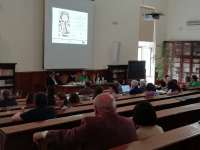
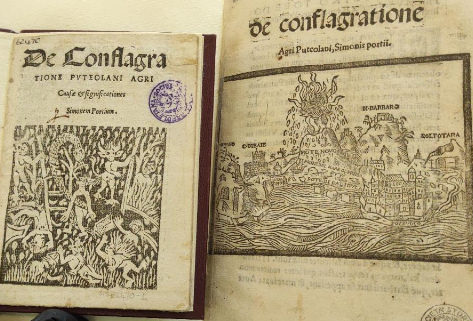
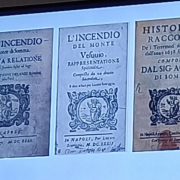

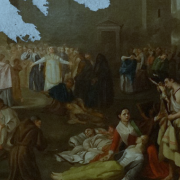

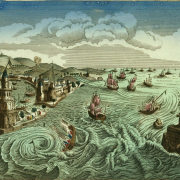
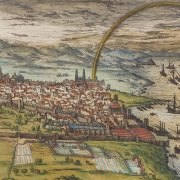





Leave a Reply
Want to join the discussion?Feel free to contribute!